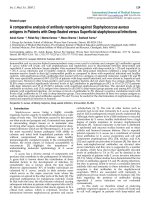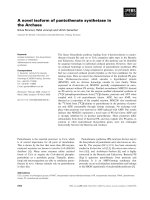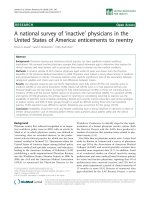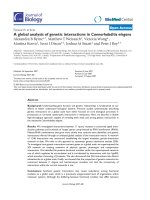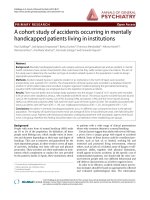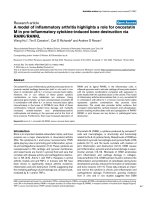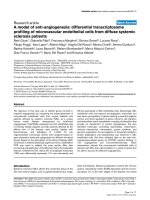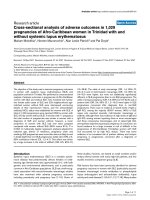Báo cáo y học: "A model analysis of static stress in the vestibular membranes" ppsx
Bạn đang xem bản rút gọn của tài liệu. Xem và tải ngay bản đầy đủ của tài liệu tại đây (1.14 MB, 8 trang )
BioMed Central
Page 1 of 8
(page number not for citation purposes)
Theoretical Biology and Medical
Modelling
Open Access
Research
A model analysis of static stress in the vestibular membranes
Daniel J Pender
Address: Department of Otolaryngology, Columbia University Medical Center New York, USA
Email: Daniel J Pender -
Abstract
Background: The scheme of the core vestibular membranes, consisting of serially connected
utricle, ampulla and semicircular canal, first appeared hundreds of millions of years ago in primitive
fish and has remained largely unchanged during the subsequent course of evolution. The labyrinths
of higher organisms build on this core structure, with the addition of the phylogenetically newer
membrane structures, namely, saccule, lagena and cochlea. An analysis of static stress in these core
vestibular membranes may contribute to a better understanding of the role of stress in the
evolution of derivative membrane structures over the long term as well as the short-term
membrane distortions seen in Meniere's disease.
Methods: A model of these core vestibular membranes is proposed in order to analyze the
distribution of stress in the walls of the component chambers. The model uses basic geometrical
elements of hollow cylinders and spheres to emulate the actual structures. These model elements
lend themselves to a mathematical analysis of static stress in their membranes.
Results: Hoop stress, akin to the stress in hoops used to reinforce barrel walls, is found to be the
predominant stress in the model membranes. The level of hoop stress depends not only on
pressure but as well on a geometric stress factor that incorporates membrane shape, thickness and
curvature. This result implies that hoop stress may be unevenly distributed in the membranes of
the several vestibular chambers due to variations in these dimensional parameters. These results
provide a theoretical framework for appraising hoop stress levels in any vestibular labyrinth whose
dimensions are known.
Conclusion: Static hoop stress disparities are likely to exist in the vestibular membranes given
their complex physical configurations. Such stress disparities may contribute to the development
of membrane pathologies as seen in Meniere's Disease. They may also factor in the evolutionary
development of other derivative membrane structures such as the saccule, the lagena, and the
cochlea found in higher animals.
Background
The core vestibular membranes in vertebrate and proto-
vertebrate fish consist of one or more ducts connected
with a number of chambers that house sensory epithelia
concerned with detection of acceleration [1] as depicted in
Figure 1. These core membrane structures are the semicir-
cular canal, the ampulla, and the utricle. This arrangement
first appears in primitive fish during the Ordovician
period some five hundred million years ago [2]. Its
scheme of interconnected canals and chambers is com-
Published: 1 September 2009
Theoretical Biology and Medical Modelling 2009, 6:19 doi:10.1186/1742-4682-6-19
Received: 19 April 2009
Accepted: 1 September 2009
This article is available from: />© 2009 Pender; licensee BioMed Central Ltd.
This is an Open Access article distributed under the terms of the Creative Commons Attribution License ( />),
which permits unrestricted use, distribution, and reproduction in any medium, provided the original work is properly cited.
Theoretical Biology and Medical Modelling 2009, 6:19 />Page 2 of 8
(page number not for citation purposes)
mon to all subsequent animal labyrinths. This feature sug-
gests that a model analysis might be helpful in
understanding the stability of these core membranes and
their potential for dysfunction under stress. Areas subject
to stress concentration could explain why membranes
evolve appendages, such as lagena, saccule, and cochlea,
or fail outright, as in Meniere's Disease.
To this end, a theoretical model is proposed that emulates
the vestibular chambers with basic geometric shapes that
are mathematically tractable. Such shapes lend them-
selves readily to a static force analysis of the relationship
between trans-mural pressure and the reactive stresses
induced in the various membrane walls [3]. The model
will be limited to the utriculo-ampullo- canal complex
from which the more elaborate structural configurations
found in higher forms derive.
Methods
In order to create a model of the basic vestibular labyrinth
that will provide insight into the biomechanics of the
component membranes, it is necessary to:
(a) evaluate the configuration of the physical mem-
branes to be emulated
(b) select ideal shapes for the model membranes
(c) describe the general mechanics of membranes
(d) define the determinants of membrane stress
The Physical Membranes
Stress is known to be dependent on membrane thickness
and membrane curvature [3]. Evaluation of these physical
parameters is thus critical to the model emulation.
Thickness of the vestibular membranes is due mainly to a
dominant layer of collagen sandwiched between thin
sheets of epithelial and mesothelial cells that form the
inner and outer surfaces of the membrane [4]. This colla-
gen layer appears to be of relatively even thickness histo-
logically [1,4]. This prominent collagen layer is assumed
to bear the brunt of the stress load in the vestibular mem-
branes. However in the absence of this collagen layer the
very thin basement membrane acting as a support for epi-
thelial cells facing the endolymphatic compartment
would become the load bearing structure [5].
The shape of the membranes in the three vestibular struc-
tures can be estimated from their descriptions and depic-
tions in the literature. The anatomical term semicircular
canal speaks to its toroidal shape. Ampulla is the diminu-
tive of the Latin 'amphora', a quasi-spherical vessel with
handles used for wine or perfume. Utriculus is the dimin-
utive of uterus from the Sanskrit 'udarum' meaning belly.
It refers to pouch-like enlargement of the oviduct for con-
taining and nourishing the fertilized egg. Its shape in the
ear has been described as a tubular [4]. The full array of
animal labyrinths preserved and depicted in stereo-photo-
graphs by AA Gray permit ready visual confirmation of
these various vestibular chamber shapes [6]. The anatom-
ical drawings of Max Brodel depict these structures in a
congruent manner [7]. These chamber morphologies are
generally consistent with a schematic drawing of the utri-
culo-ampullo- canal complex that highlights their relative
sizes and shapes and their serial interconnection [8], as
seen in Figure 2. Finally, digital reconstructions of the
toadfish vestibular labyrinth [1] confirm the toroidal,
tubular and spherical shapes of the semicircular canal, the
utricle and the ampulla, respectively.
The Model Membranes
The histological features noted above suggest that as a first
approximation the membranes can be modeled as rela-
tively uniform and isotropic. (A more complex model
would be needed to account for the fibrous nature of the
collagen layer along with its implied anisotropy. This is
beyond the scope of the current study.)
The anatomical descriptions noted above suggest the
spherical and cylindrical shapes for the model chambers.
Therefore in the current model, the narrow toroidal shape
of the semicircular canal will be construed to be a long
thin straight cylinder, the dome of the ampulla a sphere,
and the utricle a cylindrical tube. Such axially symmetric
Vestibular Labyrinth in the toadfish (after Ghanem)Figure 1
Vestibular Labyrinth in the toadfish (after Ghanem).
The toadfish vestibular labyrinth has three semicircular canals
and three ampullas connected to a common utricle.
Theoretical Biology and Medical Modelling 2009, 6:19 />Page 3 of 8
(page number not for citation purposes)
shapes permit ready determination of membrane curva-
ture, since curvature is defined as the inverse of radius.
This feature lends itself to ready data acquisition from
actual tissues when measurements are needed for numer-
ical calculations.
General Membrane Mechanics
In simple compression of a membrane, a reactive stress is
induced equal and opposite to the pressure applied. In
such a situation the reactive stress is co-linear with that
applied and unmagnified, i.e. the ratio of reactive stress to
applied pressure would be unity. However, in a sus-
pended thin membrane, e.g. a trampoline, the trans-
mural pressure is resisted by two orthogonal tensile
stresses that develop in the curved plane of the membrane
as it deforms as seen in Figure 3. The relative magnitude
of these stresses in the proposed model can be estimated
using the constitutive membrane equation. This equation
can be applied to any thin wall biological structure that
offers no bending resistance [3]. This requirement implies
that the membrane stresses are purely tensile or compres-
sive and thus relatively uniform.
The membrane equation is derived in basic mechanics
through a balance of forces acting on a membrane ele-
ment [9]. For any given point in a membrane with dual
curvature where pressure is balanced by two intramural
stresses, the membrane equation becomes:
Where 'p' is the trans-mural pressure level,
Where 't
x
' and 't
y
' are the intramural stresses in the two
coordinate directions,
Where 'w' is the membrane wall thickness at the point in
question, and
Where 'r
x
' and 'r
y
' are the two orthogonal radii of curva-
ture of the membrane segment.
This equation shows that the two stress components are
modulated by the dimensions of radius and wall thick-
ness. The relative magnitude of these stress component
terms can vary from point to point in the membrane as
long as the sum remains constant and equal to the trans-
mural pressure. It should be noted that stress 't' can also
be negative, ie compressive, and that curvature ('1/r') can
also be negative, i.e. reversed.
Positive and negative membrane curvatures are shown in
Figure 4. When both curvatures of a differential element
bend in the same direction, as in a trampoline, the mem-
brane is designated synclastic, and its tensile forces are
additive in opposing trans-mural pressure. Synclastic
membrane elements are found in the spherical ampulla.
When curvatures are of opposite sign, as in a saddle, the
membrane configuration is designated anticlastic with its
tensile forces oppositional and pressure balanced by their
net difference. Anticlastic membrane areas are found on
ptwr twr
xxyy
=+//
(1)
Scheme of the Vestibular Labyrinth (after Melville-Jones)Figure 2
Scheme of the Vestibular Labyrinth (after Melville-
Jones). This schematic highlights the serial organization of
the three component chambers in the basic vestibular laby-
rinth.
Forces acting on a spherical membrane elementFigure 3
Forces acting on a spherical membrane element.
Trans-mural pressure induces a reactive tension in the plane
of the membrane.
Theoretical Biology and Medical Modelling 2009, 6:19 />Page 4 of 8
(page number not for citation purposes)
the inner surface of the semicircular canal. When there is
only one curvature, the configuration may be described as
uniclastic. Such areas are encountered in the cylindrical
utricle.
Membrane Stress Determinants
The sphere and cylinder model shapes proposed above are
part of the ellipsoid family, a general figure that lends
itself to mathematical analysis.
Ellipsoids with constant circular cross section at the equa-
tor of radius 'r' and increasing axial length 'b' constitute a
continuum that ranges from a round disk to an infinite
cylinder shown in Figure 5. The general expression for
such a family of ellipsoids is given in Equation 2.
As the axial dimension grows, the ellipsoid progresses
from disk through discoid to sphere and then from ovoid
through cylindroid and asymptotically to cylinder.
Several features should be noted about stresses in ellip-
soids as illustrated in Figure 5. Membrane stress aligned
with the equator can be referred to as 'hoop' stress, akin to
the stress in hoops used to reinforce barrel walls. Mem-
brane stress running from pole to pole can be designated
as 'meridional' akin to the prime meridian line of longi-
tude. In flattened discoid shapes (oblate spheroids),
meridional stress is always the dominant stress and will
always be maximal at the poles; the flatter the discoid, the
higher the polar meridional stress, since flat membranes
cannot offer resistance to trans-mural pressure. None of
the vestibular chambers under consideration appears to
be of this configuration. In the perfect spherical shape, the
geometrical symmetry implies that hoop stress and merid-
ional stress must be equal. Beyond this, in elongated ellip-
soid shapes (prolate spheroids), i.e. in the model range
from sphere to cylinder, hoop stress becomes the domi-
nant stress and is always maximum at the equator where
girth is greatest and hoop curvature least. As the sphere
lengthens into an ovoid shape and then a cylindroid, the
axial curvature lessens and with it the contribution of
meridional stress to resisting trans-mural pressure. As a
consequence, in ellipsoid figures of constant diameter at
the equator, the membrane equation implies that hoop
stress at the equator gradually increases with axial length
until it reaches the maximum associated with a uniclastic
cylindrical shape [9].
Mathematically, these considerations are implicit in Equa-
tion 3 that describes the hoop stress at the equator of a
family of ellipsoids of constant equatorial diameter [9] in
terms of its several parameters:
xr yr zb 1
22 22 2 2
///++ =
(2)
t1r2brwp
hoop
22
=−(/)(/)()
(3)
Membrane ConfigurationsFigure 4
Membrane Configurations. There are three possible
shapes that a membrane may assume.
Family of Ellipsoids with circular cross-sectionFigure 5
Family of Ellipsoids with circular cross-section. As a cylindrical shape is approached, the gradual lessening of axial curva-
ture necessitates an increasing hoop stress.
Theoretical Biology and Medical Modelling 2009, 6:19 />Page 5 of 8
(page number not for citation purposes)
Where 't
hoop
' designates hoop stress at the equator
'r' designates hoop radius at the equator
'w' designates membrane thickness
'b' designates the axial semimajor dimension of the the
ellipsoid.
'p' designates transmural pressure.
Note that when 'r' equals 'b' the figure is a sphere of radius
'r' and Equation 3 becomes
When 'b' is infinite the figure becomes a cylinder of radius
'r' and Equation 3 becomes
It should be noted that other smaller stresses can exist in
the model membranes in addition to predominant hoop
stresses. Maximum membrane shear stress exists in a 45
degrees plane and is one half the difference between the
two principal stresses acting on a membrane element [9].
Radial stress, oriented perpendicular to the membrane
surface exists only in thicker membranes [10] but is negli-
gible in thin membranes with no bending resistance [3].
Thinness of a membrane is reflected in the ratio of radius
to wall thickness. Values greater than five indicate that the
diameter of the chamber is ten fold that of the wall thick-
ness and constitute an engineering criteria for 'thin' for
purposes of this analysis [10]. Thick membranes with a
value less than five are more apt to offer bending resist-
ance and are associated with increasingly significant levels
of radial stress as predicted theoretically by the Lame
equations [3], and their stress analyses would depart from
that presented here.
Thus, in the model, hoop stress is the only stress in the
spherical chambers while in the cylindrical chambers it is
the main stress accompanied by an axial component half
its magnitude and a shear stress component one quarter
its magnitude. Therefore the subsequent analysis will
focus on hoop stresses as being the dominant tensile stress
in all model chambers with the understanding that
smaller axial and shear stresses are also present in the
cylindrical model elements.
Results
Taken together the configurations of the several vestibular
chambers suggest a basic model of the vestibular mem-
branes that is depicted in Figure 6. It is in essence a con-
joined utriculo-ampullo-canal complex, using simple
shapes as building blocks to emulate the component
structures. The model as shown reflects the fact that the
semicircular canal always has the least diameter but defers
on the relative sizes of utricle and ampulla. The model
entails no dimensions and is intended to depict only the
interconnection of the component chambers and their
basic geometric shapes. All are in open communication
internally allowing a constant transmural pressure
throughout. Given these considerations, this basic model
is constructed so as to approximate the scheme of the ves-
tibular membranes. This model can be used to investigate
hoop stress in the vestibular membranes of any species to
the extent that the model is built of sufficient components
to reflect the species' anatomy and actual dimensions are
known. As shown, it most closely reflects the membra-
nous labyrinth of the primitive hagfish that has only one
semicircular canal. In order to model the river lamprey, a
second canal and ampulla would need be added to the
utricle and to model the oyster toadfish, a third canal and
ampulla.
As to the determinants of hoop stress levels in the model
membranes, inspection of Equation 3 indicates that it is of
the form:
Where (s) represents membrane shape, e.g. (1 - r
2
/2b
2
) for
an ellipsoid.
Where (r) represents membrane radius of curvature
(chamber size)
()()(/)()t0.5rwp
hoop
= for a sphere
(4)
()()(/)()t1.0rwp
hoop
= for a cylinder
(5)
()()(/)()tsrwp
hoop
=
(6)
Model of the Vestibular MembranesFigure 6
Model of the Vestibular Membranes. The building
blocks employed are cylinders and spheres.
Theoretical Biology and Medical Modelling 2009, 6:19 />Page 6 of 8
(page number not for citation purposes)
Where (w) represents membrane thickness
Where (p) represents transmural pressure.
Since both 's' and 'r/w' are dimensional in nature, they
may be conveniently combined and viewed as a compos-
ite geometric stress factor that controls the degree of hoop
stress induced by the transmural pressure (p). Thus for
equatorial hoop stress in an ellipsoid the geometrical
stress factor would be (1 - r
2
/2b
2
) (r/w).
Thus, in general, equatorial hoop stress in the model
membranes can be expressed as a function of pressure,
modified by a geometric stress factor '(s) (r/w)' composed
of membrane shape 's', membrane chamber size 'r', mem-
brane wall thickness 'w', as shown in Equation 6. It
should be noted that any comparison of hoop stress
between chambers, as occurs when stresses are normal-
ized, reduces to a simple ratio of geometric stress factors
since pressure is constant throughout the chambers.
Discussion
Models have long been used to gain insight into the
behavior of complex and unwieldy physical systems [11].
Dynamic vestibular models concerned with endolym-
phatic flow and its transductance by the sensory epithelia
have been reported [12,13]. The current study presents a
model of static hoop stress in the investing vestibular
membranes. These membranes constitute an irregularly
shaped complex of interconnected chambers (utricle,
ampulla and semicircular canal) [1]. Modeling of these
chambers individually with basic geometric shapes and
joining them in series permits an emulation of the core
vestibular membranes.
This model can be analyzed to investigate disparities in
membrane stress in the vestibular chambers. This analysis
shows that static hoop stress is linearly dependent on
trans-mural pressure, as well as a dimensional factor
indicative of membrane geometry. Chamber shape, size
and wall thickness all modulate the membrane stress reac-
tion through the agency of a geometric stress factor
according to the Equation 6. This geometric stress factor
'(s)(r/w)' magnifies or reduces the effect of pressure on
reactive hoop stress in the membrane walls. This implies
that while pressure may be equal throughout the model
labyrinth, hoop stress will vary from point to point
according to the local membrane geometry. Evaluation of
these several stress determinants is thus critical to under-
standing stress disparities that can provoke membrane
deformation and thus potentially play a role in evolution-
ary and disease processes.
Pressure is the active determinant of membrane hoop
stress and reflects ongoing physiological processes in the
endolymphatic tissues. In a closed endolymphatic system
this pressure can be expected to depend on the net balance
between fluid secretion and resorption. Processes that
interfere with fluid secretion such as gentamicin induced
dark cell toxicity [14] can be expected to reduce pressure
while processes that interfere with resorption such as ves-
tibular aqueduct ablation [15] can be expected to raise
pressure. This analysis shows that whatever the equilib-
rium pressure might be, hoop stress in any particular
chamber will be directly proportional to that pressure.
The geometric stress factor, as noted above, is a compos-
ite of three passive determinants of hoop stress that act in
concert to modulate the effect of pressure. A qualitative
overview of this stress modulating effect can be appreci-
ated by considering permutations of these three determi-
nants. When values are arbitrarily limited to cylinder or
sphere for shape, large or small for size, and thick or thin
for membrane thickness, then eight overall permutations
exist. Among these a small thick walled sphere would
result in a minimal geometric stress factor while a large
thin walled cylinder would result in a maximal one.
Within this range intermediate values would be encoun-
tered reflecting the variations in membrane shape size and
thickness. To get a more quantitative estimate of the effect
of the geometric stress factor on membrane hoop stress
the individual contributions of the three components
must be adduced.
Membrane shape is a passive determinant of hoop stress
in that its value depends on the configuration of the
model membrane. For members of the ellipsoid family,
the shape determinant can be precisely calculated using
the shape formula (1 - r
2
/2b
2
) presented in Equation 3. As
noted above for a spherical shape this results in a rela-
tively low value of 0.5 due to synclastic membrane ele-
ments equally sharing the pressure load. For cylindrical
shapes it results in a higher value of 1.0 since uniclastic
membrane elements have only a single curvature to bear
the pressure load. Thus assigning a spherical configura-
tion to a particular chamber imputes a lower value to its
shape determinant while assigning a cylindrical configu-
ration to a chamber imputes a higher value to its shape
determinant.
These model shape assignments seem to be reasonable.
The accuracy of using these perfect shapes to model
imperfect chambers can be assessed using the equations
noted above. For example, Equation 3 would predict that
an imperfect ampulla with a 10% asymmetry in its diam-
eters would have a computed shape determinant of 0.6 as
opposed to 0.5 for a perfect sphere, a fractional departure.
In order to assess the effect of using a simple cylinder to
model the toroidal semicircular canal, the Equation 1 can
be used. The semicircular canal toroids have an external to
Theoretical Biology and Medical Modelling 2009, 6:19 />Page 7 of 8
(page number not for citation purposes)
internal radius ratio of at least 10 in most animals [6].
Such proportions would entail a shape determinant of
0.95 for the outermost synclastic surface and 1.05 for the
innermost anticlastic surface, fractional departures from
the ideal model value of 1.0.
Thus, values for the shape determinant in the model can
be seen to range approximately from 0.5 (sphere) to 1.0
(cylinder). This implies that the overall influence of shape
on the geometric stress factor is in the range of two fold
(2×) for the model presented.
Membrane size is also a linear determinant of hoop stress
because the radial dimension of a chamber is simultane-
ously an inverse measure of surface curvature; the larger
the chamber, the greater its radius, the lesser its surface
curvature. In theory, size can be unlimited and hoop stress
along with it. However it is possible to make some esti-
mate of the size determinant by noting that the vestibular
membrane structures are contained in a bony analog, the
otic capsule, that acts as a physical limit to the relative
sizes that may be attained. Measurements of these otic
capsule cavities taken from a wide variety of preserved ani-
mal temporal bones indicate that the diameter of the
bony channel for the semicircular canal is approximately
1000 μ but can be as large as 2000 μ in the seal, while the
diameter of the bony vestibule housing the utricle can be
as large as 8 millimeters in the dromedary and 6 millime-
ters in the whale [6]. Gray makes it a point to indicate that
the membranous semicircular canal often fills the bony
channel, leaving little in the way of perilymphatic space in
most animals. Thus the maximal geometric stress factor
disparity between semicircular canal and utricle based on
the limiting sizes of these structures could be roughly esti-
mated at 8×.
Membrane thickness may be considered the most impor-
tant passive determinant of hoop stress in that it is the
substrate that actually bears the stress load. It has an
inverse relationship to stress in that the thinner the mem-
brane the higher the stress level. While the maximum
semicircular canal membrane thickness might be esti-
mated at 100 μ (10% of the 1000 μ bone canal noted
above], it is the lower limit of membrane thickness that is
of importance. In a minimal thickness membrane without
any external collagen layer, the stress bearing structure
would be the epithelial cell basement membrane which
has an approximate thickness of 1 μ. [16] Thus the maxi-
mal geometric stress factor disparity due to differences in
membrane thickness between chambers could be as much
as one hundred fold (100×).
These estimates of the individual contributions of the
stress determinants can be used to estimate the potential
magnifying effect of geometric stress factor on hoop stress.
With a two fold shape effect, an eight fold size effect, and
a hundred fold thickness effect, the composite effect of
membrane geometry on hoop stress could be as much as
sixteen hundred fold. Restated in terms of the model per-
mutations noted above, one could expect a large thin
walled cylinder to potentially experience a hoop stress
level 1600× that of a small thick walled sphere.
Given this theoretical possibility for large hoop stress dis-
parities to exist in the membranes of the labyrinth due to
its complex configuration, it remains to be seen how
Nature accommodates this biomechanical vulnerability.
Does Nature adjust the configurational determinants of
stress to keep hoop stress low and relatively uniform.
Does she increase membrane thickness to offset adverse
shape or use favorable shape to offset adverse size? Or
does Nature tolerate the presence of substantial stress dis-
parities despite the attendant risk of membrane failure.
While the final answer to this question must await actual
tissue measurements in individual labyrinths, some brief
speculations may be in order.
Speculative Considerations
Nature appears to abhor uniformity in favor of variety
when it comes to evolution. The large array of extinct
forms in the fossil record, the enormous variety of living
species, and the visible differences between the legions of
individuals may all be a part of a single evolutionary spec-
trum. In fact, individual differences in Darwin's view rep-
resent the current day manifestation of evolution [17].
And genetic recombination during meiosis [18] virtually
guarantees some degree of difference between individuals,
whether it be in facial appearance, fingerprint pattern or
navigational facility.
Thus some degree of disparity in geometric stress factor
might be expected to attend evolutive tendencies in the
vestibular membranes. Given the slow pace of evolution,
such disparity in geometric stress factor would likely be
small in most individuals and of no functional signifi-
cance. However, substantial disparity in vestibular mem-
brane geometric stress factor would be expected to occur
sporadically in individuals [17] and to be attended by sig-
nificant functional change. The visible changes in the lab-
yrinthine membranes in Meniere's disease [19] may
represent evidence of this latter sort. Thus Meniere's dis-
ease may provide a window into the process by which
configurational membrane changes come about. To the
extent that such changes involve the membranes' geomet-
ric stress factor, analysis of this factor may provide a tool
for investigating the etiology of Meniere's Disease as well
as for studying the evolution of the labyrinth itself.
Conclusion
A model is presented that uses basic geometric shapes to
emulate the scheme of the core vestibular membranes.
The model is quite flexible in that its component parts can
Theoretical Biology and Medical Modelling 2009, 6:19 />Page 8 of 8
(page number not for citation purposes)
be configured to accommodate any particular species.
Analysis of this model shows that the level of static hoop
stress induced by trans-mural pressure is a function not
only of pressure but of the membrane's structural geome-
try as well and as such will vary as the dimensions vary.
The hoop stress induced per unit of applied pressure can
be very large in a thin membrane of very low curvature
and, conversely, the hoop stress in a thick highly curved
membrane can be quite low, when exposed to the same
trans-mural pressure. Indeed hoop stress can vary from
point to point within the membrane of a pressurized ves-
sel of irregular shape, depending on the shape, thickness
and curvature of the membrane at the point in question.
This point is counterintuitive and deserves emphasis.
Constant static transmural pressure throughout the laby-
rinth does NOT imply a constant level of hoop stress in
the variously configured containment membranes. The
convoluted shape of the membranous labyrinth thus
implies a continuum of hoop stress levels throughout its
membranes. Such stress disparities may play a role in the
development of membrane pathologies as seen in
Meniere's Disease. They may also factor in the evolution-
ary development of other derivative membrane structures
such as the saccule, the lagena, and the cochlea found in
higher animals.
In sum, this model analysis has identified the approxi-
mate shapes of the vestibular chamber membranes, has
selected classical geometric shapes of sphere and cylinder
to emulate those chambers in a model of the vestibular
membranes, has identified a composite dimensional
parameter herein termed the geometric stress factor that
reflects a membrane's susceptibility to hoop stress, and
has shown that this geometric stress factor can be used to
analyze hoop stress disparities in vestibular chambers of
any species whose real membranes approximate those of
the model and whose dimensions are known.
Competing interests
The author declares that he has no competing interests.
Authors' contributions
DJP conceived and carried out this analysis and is solely
responsible for its content and has read and approved the
final manuscript.
Authors' informations
DJP has a longstanding interest in the architecture of the
membranous labyrinth. He completed a fellowship in
Otopathology and Electron Microscopy at Harvard Medi-
cal School. He has lectured on temporal bone anatomy
and disease at the Columbia University Medical Center.
He is a physician who specializes in diseases of the ear and
holds the position of Associate Clinical Professor of
Otolaryngology at Columbia University. He is a member
of the New York Otological Society and the International
Otopathology Society.
Acknowledgements
The author wishes to thank Christine Sullivan Metlen for her meticulous
illustrations. No funding has been received by any party in connection with
this study.
References
1. Ghanem TA, Rabbitt RD, Tresco PA: Three Dimensional Recon-
struction of the Membranous Vestibular Labyrinth in the
Toadfish, Opsanus Tau. Hearing Research 1998, 124:27-43.
2. Kuraku S, Kuratani S: Time Scale for Cyclostome Evolution
Inferred With a Phylogenetic Diagnosis of Hagfish and Lam-
prey Cdna Sequences. Zool Sci 2007, 23:1053-1064.
3. Fung YC: Biomechanics: Mechanical Properties of Living Tissues New
York: Springer-Verlag; 1993.
4. Kimura RS: Distribution, Structure and Function of the Dark
Cells of the Vestibular Labyrinth. Ann Otol Rhinol Laryngol 1969,
78:542-561.
5. Shinozaki N, Kimura RS: Scanning Electron Microscopic Obser-
vations in the Distended Reissner's and Saccular Membranes
in the Guinea Pig. Acta Otolaryngol 1980, 90:370-384.
6. Gray AA: The Labyrinths of Animals London: J&A Churchill; 1907.
7. Brodel M, Malone PD, Guild SR, Crowe SJ: Three Unpublished Drawings
of the Anatomy of the Human Ear Philadelphia: Saunders; 1946.
8. Melville-Jones G: Organization of Neural Control in the Vesti-
bulo-Ocular Relfex Arc. In The Control of Eye Movements Edited by:
Bach-Y-Rita P, Collins CC, Hyde JE. New York: Academic Press;
1971.
9. Fryer DM, Harvey JF: High Pressure Vessels New York: Chapman &
Hall; 1998.
10. Shigley JE, Mischke CR, Budynas RG: Mechanical Engineering Design
New York: McGraw-Hill; 2004.
11. Baek S, Rajagopal KR, Humphrey JD: A Theoretical Model of
Enlarging Intracranial Fusiform Aneurisms. J Biomech Eng'g
2006, 128:142-149.
12. Oman CM, Marcus EN, Curthoys IS: The Influence of Semicircu-
lar Canal Morphology on Endolymph Flow Dynamics. ACTA
Otolaryngol 1987, 103:1-13.
13. Rabbitt RD, Boyle R, Highstein SM: Sensory Transduction of
Head Velocity and Acceleration in a Toadfish Horizontal
Semicircular Canal. J Neurophysiol 1994, 72:1041-1048.
14. Pender DJ: Gentamicin Tympanoclysis:Effects on the Vestibu-
lar Secretory Cells. AM J Otolaryngol
1985, 6:358-367.
15. Kimura RS: Experimental Blockage of the Endolymphatic
Duct and Sac and Its Effect on the Inner Ear of the Guinea
Pig. A Study on Endolymphatic Hydrops. Ann Otol Rhinol Laryn-
gol 1967, 76:664-687.
16. Santi PA: Cochlear Microanatomy and Ultrastructure. In Phys-
iology of the Ear Edited by: Jahn AF, Santos-Sacchi J. New York: Raven;
1988:196.
17. Darwin C: On the Origin of Species London: John Murray; 1859.
18. Creighton HB, McClintock B: A Correlation of Cytological and
Genetical Crossing-Over in Zea Mays. Proc Nat Acad Sci 1931,
17:492-497.
19. Sennaroolu L, Linthicum FH: Histopathology of Meniere's Dis-
ease. Am J Otol 2000, 21:889.
